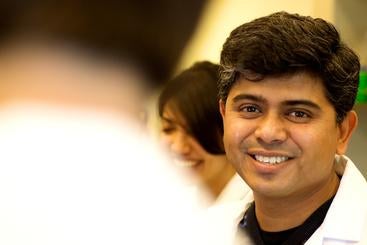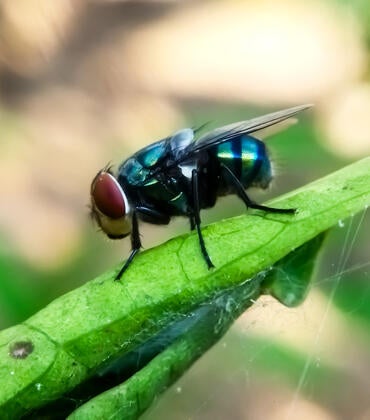
A venture capital fund created to help faculty and alumni of the University of California, Riverside, move their marketable discoveries to the buying public made its second investment late last month. The funding will allow the startup company Sensorygen to develop a sweet-smelling mosquito repellent that’s effective, safe, natural, and affordable.
The Highlander Venture Fund (HVF) invested $50,000 — with an option for up to $450,000 more — in the South Pasadena-based Sensorygen on Jan. 30, said HVF Managing Director Dave Schwab.
Sensorygen was started in 2015 by molecular biologist and neuroscientist Anandasankar “Anand” Ray, who has firsthand experience with mosquito-borne illnesses. He had malaria when he was growing up in India, and his wife was hospitalized with dengue fever. She has since recovered, but the experiences narrowed Ray’s research interests when he started his lab at UCR in 2007 to explore findings that showed mosquitoes used scent to track their human prey.
“I wanted to know how insects smell us out, and how we can find ways to fool them,” said Ray, an associate professor in UCR’s Department of Molecular, Cell, and Systems Biology.
He and his researchers tested about 6,000 properties to discover ones that make a good repellent. Chief among their priorities was finding safe, natural chemicals that didn’t have the potentially harmful properties of N,N-diethyl-m-toluamide, commonly known as DEET. The artificial chemical repels mosquitoes but also dissolves plastics and binds to some human protein targets.
The new repellents should be long-lasting and also smell nice, unlike citronella or natural oils that have a strong fragrance to deter mosquitoes. It should be affordable and easy to produce, and as simple to use as cosmetics, Ray said.
Matching those properties against a list of 500,000 chemicals could take several lifetimes, said Sensorygen CEO Thomas Stone. But Ray developed a software pipeline using artificial intelligence that quickly matches the desired properties against that long list of chemicals.
“The computer spits out a long list of what the best matches are, and that makes it easier for us to refine the list and start testing,” Stone said.
They have narrowed down the list to six naturally occurring chemicals, some of which are used for food flavorings but, as it turns out, are also effective at repelling mosquitoes, Stone said.
Sensorygen is presently in discussions with major companies to take the repellent and possibly other products to markets around the world. Stone estimates the mosquito repellent should be ready for sale in about two years.
After that, Sensorygen hopes to use the same technology and science to create repellents for other insects, such as bedbugs, ticks, and ants, as well as new fragrances and flavors for foods and cosmetics, and safe, effective insect repellents for farmers, some of which are already being tested against the Asian citrus psyllid in Florida by a licensee.
But first, Ray wants to take down the mosquito.
“I always thought we could confound or exploit that aspect of mosquitoes using their sense of smell to find us,” he said, “and here we are, using the power of computation biology and our deep understanding of the insect sensory system to develop the next generation of mosquito repellents to prevent transmission of Zika, dengue fever, malaria, West Nile virus, and other diseases that put at risk nearly half the world’s population.”
Ray’s passion and skill fit the Highlander Venture Fund’s three main criteria for choosing new firms to invest in, Schwab said.
“We like things where there’s a real clear problem, a large and painful problem, and for most people, putting toxic things like DEET on their body is a problem that needs to be solved,” he explained.
“The fund is also keen on intellectual property — ideas that have already been patented — which is one reason why Riverside’s investments are so exciting, because UCR has substantial intellectual property developed by really, really bright people at the school,” Schwab continued.
Finally, “it’s really all about the people,” he said. The companies need strong players, “and both Tom Stone and Dr. Ray are very, very strong people, smart, experienced, and able to execute.”
The Highlander Venture Fund has raised nearly $5 million since it started in June 2017 — about half of its $10 million funding goal.
“That’s a very good start,” Schwab said. “Typically it takes a couple of years to completely raise the funds, so we’re in great shape.”
The UCR Foundation committed $2 million to the fund as one of its first qualified investors. The fund is only open to qualified or accredited investors — that is, investors with an annual income of $200,000 for the past two years or a net worth of at least $1 million, excluding the value of their home.
The fund’s first investment was in early January for the San Diego-based company NanoCellect Biomedical Inc., founded in 2009 by biochemist Jose Morachis, a UCR alumnus. Schwab said he expects a few more 2018 investments to be announced later this year.
The fund is an important boost to UCR’s researchers, who often need seed money and support to move their discoveries out of the lab and into the marketplace, Ray said.
“It fills a vital gap in the funding process for taking discoveries from the bench to a shelf,” he added, “and it shows commitment from the university to enable some of its best and brightest scientists and inventors to push forward with their discoveries.”




